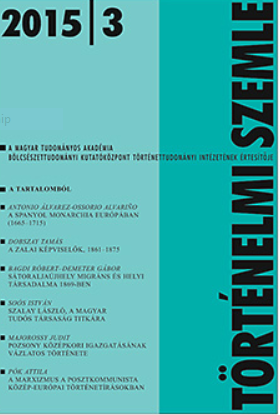Sátoraljaújhely migráns és helyi társadalma az 1869. évi népszámlálás alapján
The Characteristics of the Indigenous and Local Societies of Sátoraljaújhely Based on the Results of the Census in 1869
Author(s): Róbert Bagdi, Gabor DemeterSubject(s): Geography, Regional studies, Demography and human biology, 19th Century, Migration Studies, Socio-Economic Research
Published by: Magyar Tudományos Akadémia Bölcsészettudományi Kutatóközpont Történettudományi Intézet
Keywords: Sátoraljaújhely; 1869; characteristics of the indigenous and local societies; demography; migration;
Summary/Abstract: In our contribution we aimed to examine the role of immigration and vertical mobility in the reproduction and transformation of local urban societies using the original data of the census in 1869. The hypothesis was, that if urbanization/industrialization had begun by that time, differences should be traced between the social structure of immigrant and indigenous societies (former referring to the demand) compared to the city as ’total’. The change in social status of consecutive generations may also reflect the effects generated by accelerating urbanization and economic development. We investigated (1) the geographical source areas of immigration to identify the extension of attraction zones and directions of movements; (2) the different types and motives of increasing horizontal mobility; (3) the social structure and occupational distribution of newcomers; (4) the differences between the social and occupational status of local and immigrant society; (5) the change in social status in a thirty-year time-span. To measure the significance of the migration processes compared to the ’expected average’, the town in a ’twilight zone’, Eger was selected as a control. The two towns, Eger and Sátoraljaújhely were similar in certain aspects. Both (1) had relatively small zone of attraction (could not even cover the territory of the county); (2) had the same number of inhabitants by the turn of the 19–20th century; (3) had similar employment structure and similar agriculture; (4) represented the same hierarchical level of administration and urbanization, considered as half-periphery; (5) were located along the ’market line’, where the products of hills were exchanged for the products of plains, where N–S and E–W lines of traffic and communication crossed each other. However, the 2 county seats showed remarkable differences that influenced the rate and level of development, and the attraction on people: (1) the rate of development of Sátoraljaújhely was quicker in the last few decades: while Eger was stagnating after an early period of development (1700–1840) conserving traditional social patterns, Sátoraljaújhely turned a small ’melting pot’ owing to the industrialization (railway); (2) the migrational patterns were different; (3) the openness of society also differed; (4) the religious and ethnic pattern of the surrounding was different.
Journal: Történelmi Szemle
- Issue Year: 2015
- Issue No: 03
- Page Range: 381-410
- Page Count: 30
- Language: Hungarian

